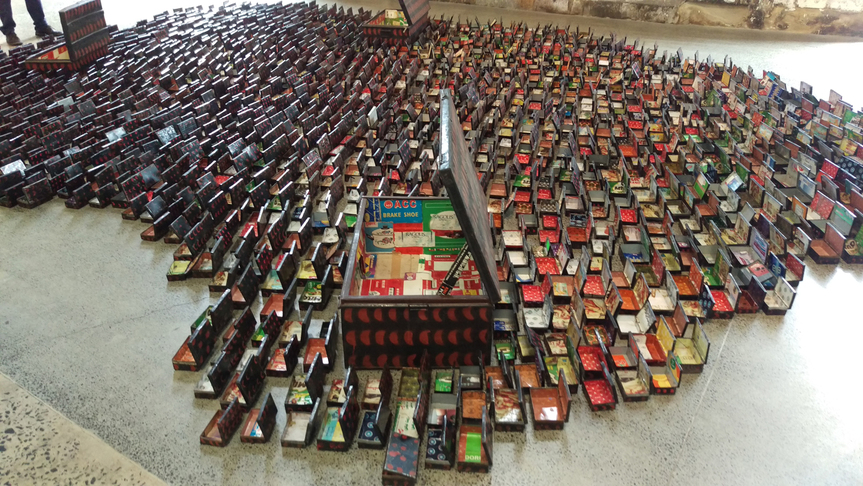
R
E
V N
E
X
T
The multicolored shirt that Ghana-born, Nigeria-based artist El Anatsui was wearing at the launch of his first Australian solo show, “El Anatsui: Five Decades” at Sydney’s Carriageworks, clashed harshly with his multicolored monumental sculptures, which hung in elegant swags within the venue’s industrial space like shimmering medieval tapestries. While Anatsui’s works—each one made from thousands of linked bottle tops—coalesce into subtle, aesthetically satisfying color drifts, his shirt, in stark contrast, screamed for attention.
“El Anatsui: Five Decades” is, nonetheless, a remarkable survey of contemporary art by an artist who has taken the global art world by storm in recent years. In Susan Vogel’s documentary on Anatsui, Fold Crumple Crush (2011), his work has been succinctly summed up by the distinguished art critic Robert Storr as the “recycling of industrial production into something that is completely transcendental, made out of junk.”
EL ANATSUI, Adinkra Sasa (detail), 2003, fabric, aluminum and copper wire, 488 × 549 cm. Photo by Michael Young for ArtAsiaPacific.
The junk in question are the otherwise discarded caps from bottles of whiskey, rum and gin, bearing names such as Flying Horse, Castello, Bakassi, Liquor Headmaster, Ecomog and Dark Sailor. They are joined together with copper wire into magnificent faux cloths of limitless dimensions; “faux,” because they are not cloths at all, but are described by Anatsui as sculptures that have the potential to change their shape at every outing, and contain within their DNA a startling visceral presence and thoroughly contemporary appeal tempered by an African joie de vivre. They also possess a hidden sinister side that references colonialism, migration and how consumption leads to waste.
At the exhibition opening, Anatsui told ArtAsiaPacific the story about how his amassing of bottle-caps started in 1998. He found a bag of them discarded by the road, close to where he was living in Nigeria at the time. He took it back to the studio where it lay for a couple of years before he realized it was saying something to him. “It takes time to find out what you can do,” Anatsui noted. Eventually, there was a eureka moment when he realized that if he put them together in one mass, he could say something with them.
The earlier works in the bottle-cap series used only the rims of the tops, cut apart from the discs and flattened. Only later when Anatsui saw the unused discs did he realize that he could do something with them, too. In creating the works today, all are joined together with copper wire by numerous assistants in relatively small, color-coordinated sheets of about 200 tops, which are laid flat on the studio floor before being merged into monumental spreads. “They started relatively small in scale, but [soon] grew to two-by-two meters, and then four-by-four meters; but I have since discovered they can go to [even] larger dimensions,” he said somewhat self-deprecatingly.
Anatsui’s creative process, which begins at his studio and continues through to the final hanging of his work at an exhibition space, is ever evolving, with each individual piece possessing an aesthetic potential that is not fully realized until it is exhibited. “When the work is finished on the studio floor, that is not the end; rather, it is the beginning of the work’s life. Everything changes all the time.” Anatsui believes in serendipity and chance. Each iteration of a particular work is different, because of such “collaborative” processes.
“You can put them on the floor, hang them from a wall or drape them over things. The potential is limitless, and I’ve worked toward this [concept] from early in my career—the freedom to change and be changed,” he said. “When I was an art student, what I was shown as art was fixed for centuries. I thought that if art is something that replicates life, if art is life, then it is not static, because life is not static. Life is dynamic, so art should be something that has similar properties,” he added.
Anatsui’s incredible, dazzling sculptures, 30 in all at Carriageworks’s sumptuous exhibition, are like propositions containing within them a limitless opportunity to morph into something different, which—I couldn’t help but observe—was not like the shirt the artist was wearing at the opening.






